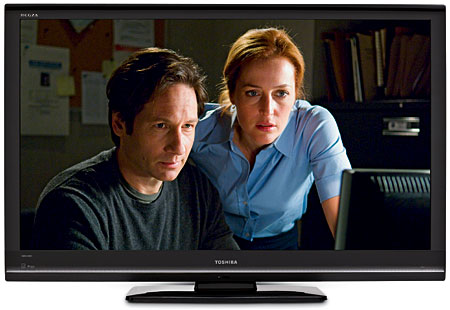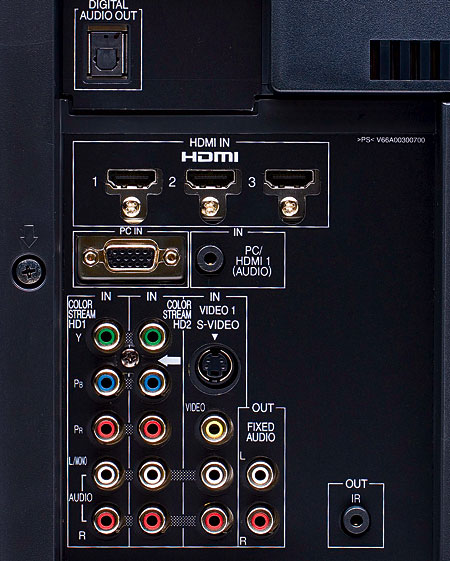Toshiba 52XV545U LCD HDTV
Upscale Performance
With the format war behind it, Toshiba is concentrating on improving the look of standard-definition content on high-def displays. A new upconversion-enhancement technology called Super Resolution Technology (SRT) is now available in some of Toshiba’s latest LCD HDTVs, including the top-of-the-line Cinema Series. The largest of this series is the 52-inch 52XV545U reviewed here, and 46- and 42-inch versions also available.

Features
Perhaps the 52XV545U’s most important feature is its SRT, which purports to sharpen standard-def and 720p material as the display upconverts it to 1080p. This is akin to—but different than—the XDE technology found in Toshiba’s XD-E500 DVD player, which doesn’t work very well at all. I was eager to see if SRT would do any better.
Like most high-end LCDs these days, the 52XV545U features 120-hertz operation. It flashes frames on the screen at a rate of 120 per second, which is twice the typical video rate of 60 Hz and five times the film frame rate of 24 fps. In conjunction with ClearFrame—Toshiba’s frame-interpolation algorithm—this is designed to reduce the motion blur that has plagued LCDs since their introduction.
Frame interpolation creates new frames and inserts them between the actual frames in a video signal. In order to smooth out the motion and sharpen the image, it calculates where moving objects should be in those new frames. However, this process can introduce artifacts of its own.
Unlike some high-end LCDs, the Toshiba doesn’t include LED backlighting with local dimming. The sets that boast this feature are the current state of the art in blacks and contrast. But as you’ll read, this Toshiba does have excellent blacks and shadow detail for a conventional LCD without local dimming.
Color-point adjustment is becoming more common, and Toshiba’s version is called ColorMaster. This lets you tweak the hue, saturation, and brightness of each primary (red, green, blue) and secondary (cyan, magenta, yellow) color, which effectively moves the color points as needed to provide an accurate color gamut. (See this issue’s “Gear Works” for more on the subject.) This is a potentially great feature, but you shouldn’t attempt to use it without the requisite tools and training.
 User Interface
User Interface
As with many HDTVs these days, the remote is a universal type that can control up to three devices other than the TV. It’s not illuminated, but the selected device button momentarily lights up when you press any other button to show you what device you’re controlling. All of the buttons appear to be translucent, so they could easily be backlit.
The remote has a fairly well organized and differentiated layout, although the buttons that surround the cursor cluster are grouped in pairs on rockers—you push one side for one thing and the other side for another. This is a bit awkward and cluttered looking, and these buttons are hard to find by feel.
The menu system is not my favorite. The picture controls are two levels deep, and the advanced settings are located on another deeper level. Granted, once you set these parameters you probably won’t need to adjust them much, but I’ve seen menu designs that make them more immediately accessible. Happily, the picture settings are independent for each input.
The organization isn’t bad overall, and the menu opens to the last item you were working with, which is very nice. The selected picture control drops to the bottom of the screen, and the rest of the menu disappears, as it should. However, it times out after only six seconds of inactivity, which is too short in my book. Also, if you adjust a picture control and then press up or down, the entire menu reappears. It should cycle through the controls one by one at the bottom of the screen.
Setup and Tests
Like virtually all HDTVs, the 52XV545U offers several picture modes. The Movie mode was actually quite close to the optimum picture settings, although blacks were a bit crushed (Brightness was a little too low), and whites were a bit clipped (Contrast was a little too high). If you tweak any of the settings in a preset mode, the mode automatically switches to Preference, which can be confusing.

When you adjust the picture controls, you can start with any picture mode, including the one labeled Preference. However, when I selected the Preference mode and started entering my settings, I was surprised to find very pronounced ringing—ghostly white halos surrounding black lines on a gray background. Even more surprising, when I selected the Movie mode and adjusted its settings (which caused the mode to switch to Preference), there was no ringing to be seen, even though the Sharpness setting was the same in both cases. Obviously, it’s better to tweak the picture controls in the Movie mode than to start in the Preference mode.




























































